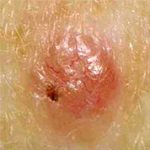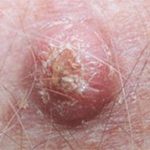SKIN CANCER RECONSTRUCTION
There Are Several Types of Skin Cancer

Skin cancer is very common in Australia and New Zealand.
The sunny environment in Australia and New Zealand along with our outdoor lifestyle tends to expose us to more UV radiation than in many other parts of the world.
Your skin type can also be a factor, the lighter skinned you are the more you are likely to develop skin cancer and this in combination with our outdoor lifestyle is why we have such a high incidence of skin cancer here.
The skin cancers we most commonly see in Australia are:
Basal Cell Carcinoma (BCC)
Squamous Cell Carcinoma (SCC)
Melanoma.
There are other types of course, but here we will focus these three.
What is a Basal Cell Carcinoma (BCC)?
 BCC is a slower growing variety of skin cancer that rarely goes anywhere else. It slowly grows where it is over many years and if caught early before it grows large it can be safely and effective treated and the problem removed.
BCC is a slower growing variety of skin cancer that rarely goes anywhere else. It slowly grows where it is over many years and if caught early before it grows large it can be safely and effective treated and the problem removed.
A Biopsy is Necessary A tissue sample is taken and examined by a pathologist. This is important because it tells us what sub-type the carcinoma is. There are slower growing sub-types (for example “nodular” type) that do not spread to other parts of the body but there are aggressive sub-types too (such as “infiltrative”) which demand more rapid intervention.
The biology of BCC is important and will indicate the best method of treatment. Where more aggressive forms are found, more aggressive treatment may be needed.
Surgical removal of BCC is a good treatment but there are alternatives depending in the sub-type. Some cancers can be treated with cream alone or other non surgical methods.
If the tumour is small enough it can often be treated under local anaesthetic in an office setting. For those that are not fond of needles, facilities for “twilight sedation” can be arranged- such sedation arrangement means no general anaesthetics but no pain of the needle when the local anaesthetic is going in.
For more complex cases general anaesthetic may be considered and discussed with you.
TIMELINESS IS VERY IMPORTANT.
Early detection usually leads to a successful outcome so consult your skin specialist, dermatologist and specialist plastic surgeon as soon as possible if you have concerns.
Contact Us for a Timely Appointment
What is a Squamous Cell Carcinoma (SCC)?
SCC originates in the spinosum or melphighian part of the top layer of the skin.
 Sun Spots The majority of the SCC’s arises from “sun spots”- these red and scaly spots on the sun exposed part of the skin if left can progress into a SCC. It is common to have those “frozen off” at your doctor but those that persist need closer attention.
Sun Spots The majority of the SCC’s arises from “sun spots”- these red and scaly spots on the sun exposed part of the skin if left can progress into a SCC. It is common to have those “frozen off” at your doctor but those that persist need closer attention.
Much like BCCs, SCCs can be divided into a low risk form (well differentiated) and aggressive forms (poorly differentiated) with grades of aggressiveness in between.
The poorer the biology of the disease the more aggressive the treatment must be, because it can often travel in lymph channels into nearby lymph glands and it can also travel to nearby nerves.
REGULAR SKIN CHECKS ARE A MUST
Left untreated Basal Cell Carcinoma will continue to grow and become more difficult to treat. Regular skin checks will help prevent this from happening.
What is Melanoma?
Melanocytes are cells in your skin that act to protect your skin from harmful effects of the sun by providing “window shading” of sorts.  Sometimes these melanocytes turn into cancer and these are called Melanoma.
Sometimes these melanocytes turn into cancer and these are called Melanoma.
Melanoma if left untreated can be dangerous and even fatal. This is because when melanocyte turn into cancer in the top layer of skin it begins to burrow downwards into deeper tissues.
Once it starts to invade into deeper tissues it can travel to local lymph glands and even distant organs such as brain and liver.
Regular Checkups It is crucial to have a regular skin check especially if you have had melanoma in the past or you have a family history of melanoma.
If caught early it can be treated safely and effectively with surgery.
MEMORIZE THE BELOW A B C D E OF MELANOMA
One feature from below doesn’t necessarily mean it is melanoma, but you need to watch out for signs of change.
A- Asymmetry. If you can’t divide the dark spot into 2 equal halves it’s a warning sign. For example a perfect circle is better than a map of Australia.
B- Border. A clear border, where you can easily tell “this is where the dark spot stops and this is where the normal skin begins” is a good thing. If the edges or the border looks like someone had spilt ink it is a warning sign.
C- Colour. One uniform colour of say light brown is okay. Multiple colour’s of red, blue and black is not.
D- Diameter greater than 6mm. Bigger than 6mm of greatest dimension needs a closer look.
E- Elevation (it’s raised) or Evolution–
Is it Changing.
If you’ve had a dark spot that is changing, see us IMMEDIATELY, we will fit you in.
Contact Us for a Timely Appointment
What are Treatment Options for Skin Cancer
Treatment needs to be individually tailored to each person. The biology of the skin cancer, the location of the tumor and the circumstance of each person must be considered. Ask us and we will explain the steps for you.
Once a diagnosis is made, a tailored planned will be made specifically for you.
The above are examples only. You must consult a specialist prior to embarking upon treatment.
Treatment may consist of:
Non surgical options- include topical creams, light therapy, radiotherapy
Surgery – Excision and reconstruction but also curette and electrocautery.
Contact Us for a Timely Appointment
Reconstruction After Surgical Cancer Removal

Each skin cancer, its treatment and reconstruction will be tailored to you. Generally, there are four surgical options.
Direct closure (also known as Primary Closure)- The direction of the resulting scar is crucial in achieving the optimal cosmesis. The resulting defect after the skin cancer has been removed are brought together in a single line.
Local flap closure– by “borrowing” local tissue and rearranging the tissue we are able to reconstruct the defect from the skin cancer surgery. There are many different types of local flaps and needs to be carefully chosen for the given location on the body.
Skin graft– In essence it is a skin transplant where we “harvest” skin from one site and put it on another. It may be a thin skin in case of “split skin graft” or the full depth of skin called “full thickness” skin graft. These different types of skin grafts need to be carefully selected for that location on that particular patient.
Distant flap closure – in some cases, usually large cancers there may not be enough local tissue to be able to reconstruct the defect. In this case we borrow from a distant site for reconstruction. This is common place in case of large head and neck cancers as well as breast reconstructions.
What Can I Do About Scars From Surgery?
Following surgery we embark upon a rigorous scar management strategy to optimise the resulting scars. Feel free to read our scar management advice under Patient Resources Section.
We continue to see you, guide your resultant scar and monitor to see if further interventions are needed. Contact Us for more information
What happens after surgery?
Please read our Patient Resources Section, it outlines what happens when you have surgery with us.
You will receive a postoperative instruction sheet right after your surgery. Then when your wound has healed and cancer long gone you will receive another Scar instruction sheet designed to maximise the cosmetic appearance of the scar.
Of course, you will be seen again down the line by Dr Kim to see whether we can do anything else to optimise your scar.
Does Receiving a Local Anaesthetic Hurt
Yes there is a very brief discomfort with any injection. But there are a number of things we do to make it easier.
We warm up the local anaesthetic agent. We use an extremely fine needle and inject very slowly. After the initial dose is given, we wait for it to work before any further anaesthetic is administered. This is all part of making you experience a little better.
We even treat children under local anaesthetic to save them from having a general anaesthetic. And if you prefer, we ask for a help from Specialist Anaethetists in accredited hospitals.
We’re here to look after you and make you as comfortable as possible.
Close
GET IN TOUCH
It all starts with a conversation.
A simple question, difficult questions, anything at all... Just ask us.
We promise a timely and genuine reply- because it’s all about making sure you are properly looked after.
City Mutual Building
Level 10 Suite 1004
66 Hunter Street. Sydney 2000
© 2019 Dr Leo Kim info@quaysidespecialists.com.au
